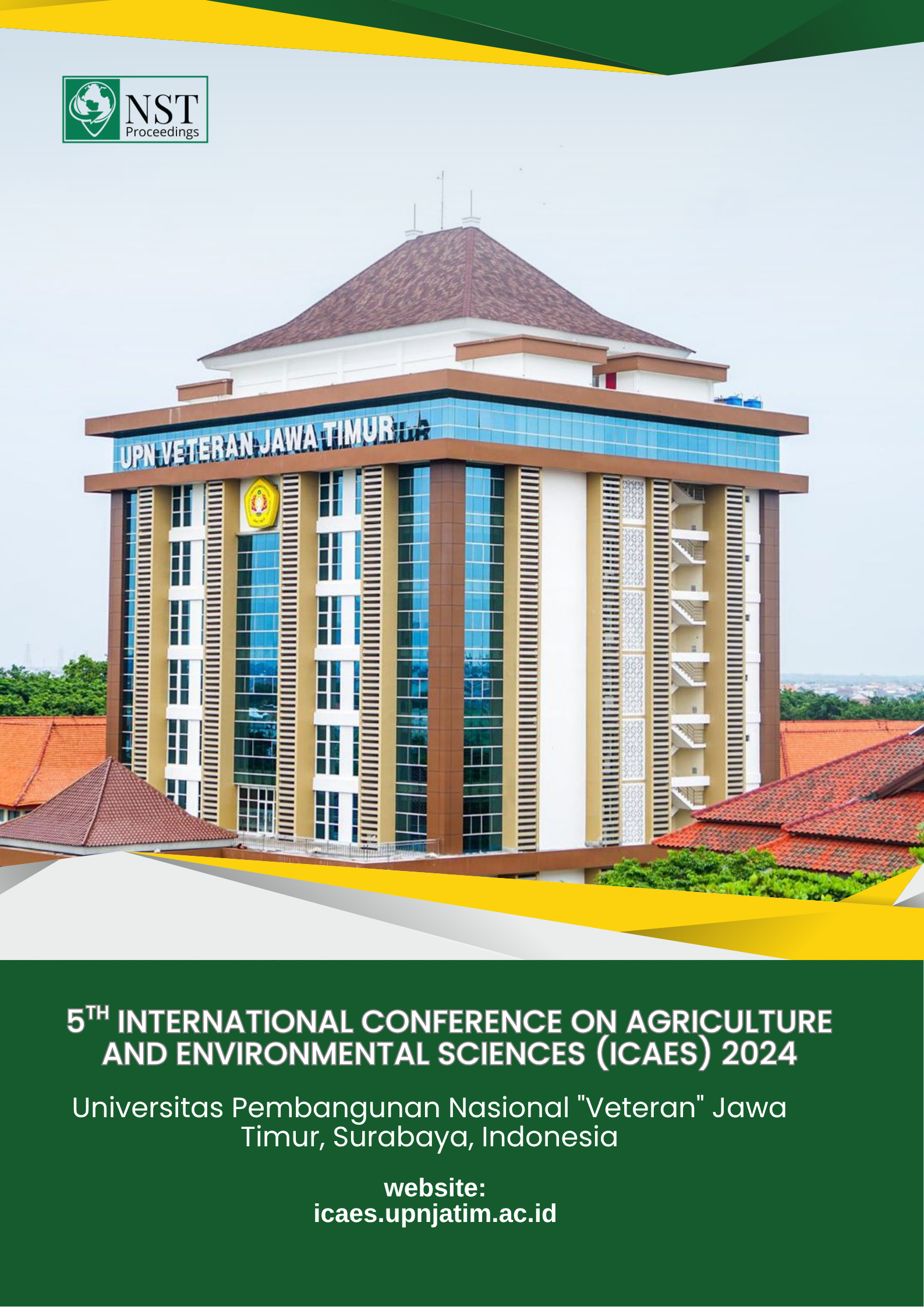Forecasting Anthracnose (Colletotrichum capsici) Attack on Chili Pepper
DOI:
https://doi.org/10.11594/nstp.2025.4905Keywords:
Crop failure, disease, horticulture, leaf blight, peppersAbstract
Chili is one of the main horticultural commodities in Indonesia. Unfortunately, chili cultivation is often constrained by attacks from plant-disturbing organisms. One of the main pests that worries chili farmers is Colletotrichum capsici, which causes anthracnose. Anthracnose disease often causes crop failure, which is detrimental to farmers. Therefore, it is necessary to forecast anthracnose disease attacks so that appropriate preventive and countermeasures can be taken. This review was written to study methods that can be used to predict anthracnose attack on chili peppers. From the literature review that has been carried out, several forecasting methods have been obtained that can be used to predict anthracnose disease attacks on chili plants, which are Geographic Information Systems (GIS), Global Positioning Systems (GPS), Remote Sensing, and Expert Systems. However, further testing of each method is still needed to prove its effectiveness and accuracy in predicting anthracnose disease in chilies.
Downloads
References
Bhattacharya, B. K., Dutta, S., Dadhwal, V. K., Parihar, J. S., Chattopadhyay, C., Agrawal, R., Kumar, V., Khan, S. A., Roy, S., & Shekhar, C. (2007). Predicting aphid (Lipaphis erysimi) growth in oilseed Brassica using near surface meteorological data from NOAA TOVS—a case study. International Journal of Remote Sensing, 28, 3759-3773
Bhupathi, P., & Sevugan, P. (2021). Application of hyperspectral remote sensing technology for plant disease forecasting: An applied review. Annals of the Romanian Society for Cell Biology, 25(6), 4555–4566.
Boskosar, R., & Wahyuni, S. (2019). Penggunaan GPS untuk mendeteksi penyebaran penyakit tungro pada dua musim tanam padi di Kecamatan Poco Ranaka Timur, Kabupaten Manggarai Timur, Propinsi Nusa Tenggara Timur. AGRICA, 12(1), 12-22.
Charaya, M. U., Upadhyay, A., Bhati, H. P., & Kumar, A. (2021). Plant disease forecasting: Past practices to emerging technologies. In: Sampat Nehra, (eds) Plant Disease: Management Strategies. p. 1-30.
Chattopadhyay, C., Bhattacharya, B. K., Kumar, V., Kumar, A., & Meena, P. D. (2011). Epidemiology and forecasting of diseases for value-added agro-advisory. Plant Pathology in India: Vision, 2030, 132-140.
Gunawan, R. (2021). Pemanfaatan penginderaan jauh terhadap kejadian Hopperburn Wereng Batang Coklat (Nilaparvata lugens Stal). Universitas Andalas. Tesis. Universitas Andalas.
Hardwick, N. (2006). Disease forecasting. In: COOKE, B., JONES, D., KAYE, B. (eds) The Epidemiology of Plant Diseases. Springer, Dordrecht.
Hatfield, P. L., & Pinter, P. J. (1993). Remote sensing for crop protection. Crop protection, 12, 403-413.
Khairul, I., Montong, V. B., & Ratulangi, M. M. (2018). Uji antagonisme Trichoderma sp. terhadap Colletotrichum Capsici penyebab penyakit antraknosa pada cabai keriting secara in Vitro. Cocos, 9(6).
Nusantara, D. O., Pamungkas, S. W., Syaifuding, N. R., Kusuma, L. W., & Fikri, J. (2017). Sistem pakar analisa penyakit pada tanaman cabai merah menggunakan Metode Backward Chaining. Seminar Nasional Teknologi Informasi dan Multimedia. STMIK AMIKOM Yogyakarta.
Ramdan, E. P., Risnawati, Kanny, P. I., Miska, M. E. E., & Lestari, S. A. (2021). Penekanan pertumbuhan Colletotrichum sp. penyebab penyakit antraknosa oleh beberapa agens hayati pada skala in Vitro. Agrium, 24(2), 68-72.
Sari, C. R., & Muammar. (2020). Sistem pakar diagnosa hama dan penyakit pada tanaman cabai berbasis website. Jurnal Teknologi Informasi Mura, 12(2), 145-155.
Sarwono, E., Nurdin, M., & Prasetyo, J. (2013). Pengaruh kitosan dan Trichoderma sp. terhadap keparahan penyakit antraknosa (Colletotrichum capsici (Syd.) Butl. et Bisby) pada buah cabai (Capsicum annuum L.). J. Agrotek Tropika, 1(3), 336-340.
Sasmito, G. W. (2010). Aplikasi sistem pakar untuk simulasi diagnosa hama dan penyakit tanaman bawang merah dan cabai menggunakan Forward Chaining dan pendekatan berbasis aturan. Tesis. Universitas Diponegoro.
Singh, I. N. (2016). Aerobiology in north-east India in the context of epidemiology and forecasting for fungal diseases of major crop plants. Int. J. Mendel, 33, 63-68.
Sriyanti, N. L. G., Suprapta, D. N., & Suada, I. K. (2015). Uji Keefektifan rizobakteri dalam menghambat pertumbuhan jamur Colletotrichum spp. penyebab antraknosa pada cabai merah (Capsicum annuum L.). Jurnal Agroekoteknologi Tropika, 4(1), 53-65.
Sukmawati, K., & Rahmah, A. (2022). Pengembangan Geographic Information System (GIS) guna pengelolaan komoditas tanaman cabai. Jurnal Informatika Terpadu, 8(2), 78-84.
Umar, R., Aziz, M., & Rahardiyan, W. D. (2018). Peringatan dini penanggulangan penyebaran hama wereng coklat dengan sistem informasi geografis. Seminar Nasional Teknologi Terapan VI: Rekayasa Sains dan Teknologi Berkelanjutan dalam Manajemen Resiko bencana.
Wibowo, D. S., Yanitasari, Y., & Dedih. (2018). Sistem pakar diagnosis potensi penyebaran penyakit pada tanaman cabai menggunakan fuzzy mamdani. Jurnal Teknologi dan Sistem Komputer, 6(2), 71-75.
Downloads
Published
Conference Proceedings Volume
Section
License

This work is licensed under a Creative Commons Attribution 4.0 International License.
Authors who publish with this proceedings agree to the following terms:
Authors retain copyright and grant the Nusantara Science and Technology Proceedings right of first publication with the work simultaneously licensed under a Creative Commons Attribution License that allows others to share the work with an acknowledgement of the work's authorship and initial publication in this proceeding.
Authors are able to enter into separate, additional contractual arrangements for the non-exclusive distribution of the proceedings published version of the work (e.g., post it to an institutional repository or publish it in a book), with an acknowledgement of its initial publication in this proceeding.
Authors are permitted and encouraged to post their work online (e.g., in institutional repositories or on their website) prior to and during the submission process, as it can lead to productive exchanges, as well as earlier and greater citation of published work (See the Effect of Open Access).










